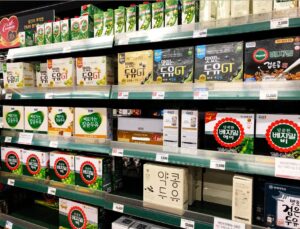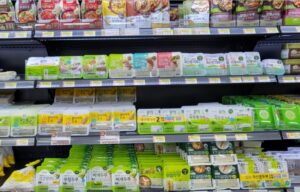American grown, international impact. U.S. soybeans provide high-quality products domestically that have a large impact beyond farm gates. U.S. Soy can be found as a product in animal feed and vegetable oil or renewable fuels. Domestic use of U.S. soy makes up approximately 40% of the annual soybean crop, while the other nearly 60% is exported as solutions in the global supply chain.
 Different regions across the globe have diverse uses for soy, creating opportunities for U.S. Soy to affect billions of lives. Regions such as the Middle East, North Africa and Europe drive demand for soy as a key ingredient in animal feeds. Places like Southeast Asia and the Americas use soy as a feed ingredient in their aquaculture industry. In Northeast Asia, U.S. Soy can be found in food and beverages. South Asia and China continue to demand soy as their populations grow, and a growing demand for protein leads to demand in Sub-Saharan Africa.
Different regions across the globe have diverse uses for soy, creating opportunities for U.S. Soy to affect billions of lives. Regions such as the Middle East, North Africa and Europe drive demand for soy as a key ingredient in animal feeds. Places like Southeast Asia and the Americas use soy as a feed ingredient in their aquaculture industry. In Northeast Asia, U.S. Soy can be found in food and beverages. South Asia and China continue to demand soy as their populations grow, and a growing demand for protein leads to demand in Sub-Saharan Africa.
U.S. Soy is positioned to serve the growing global market. It supports global vitality by meeting nutritional needs, supporting progress in global communities and by providing products that enhance quality of life.
From Elevator to River
In the 2020/2021 market year, U.S. Soy set a record for exporting more product to international markets than ever before. In this market year, 61.65 MMT of soybeans were exported as whole beans, valued at more than $28 billion in revenue for the industry. As meat, poultry and aquaculture production grow in varying regions across the globe, increased interest in processing their own soybeans grows. In fact, some countries have switched from importing soybean meal to whole soybeans with that growth. One such example is Egypt.
“One of the most common ways our U.S.-grown soybeans are exported is as whole soybeans,” said Robert Alpers, soybean farmer from Prairie Home, Missouri, and Missouri Soybean Merchandising Council board member, “Any trade partner is good for the American farmer and Egypt, who recently became the third largest importer of U.S. Soy, is one of them. I look forward to seeing where this growing market goes in the future.”
Egypt’s climb to the third largest importer of U.S. Soy is remarkable, but its cause is no secret. The booming chicken and aquaculture industries are leading the way for more soy to be crushed in the region. Egypt’s recent switch from primarily imported U.S. soybean meal to whole soybeans has opened opportunities for U.S. Soy to do training in the region, as well.
Meeting Specific Needs in a Region
While the bulk of U.S. Soy is shipped whole to its destination, certain countries need to have products already processed and ready for use.
 “If the country doesn’t have the infrastructure to do it themselves, they know they can lean on us for our high-quality soybean meal,” adds Alpers. “They can always trust U.S. Soy to have a good end product for use in their livestock feed.”
“If the country doesn’t have the infrastructure to do it themselves, they know they can lean on us for our high-quality soybean meal,” adds Alpers. “They can always trust U.S. Soy to have a good end product for use in their livestock feed.”
During the same marketing year, international markets purchased 12.3 MMT of soybean meal, with the Philippines being the top export market for the meal.
Consumers in the Philippines prefer fresh poultry and pork sources, meaning the country must meet the demand with domestically raised meat, rather than importing U.S. raised meat that has been previously frozen. Food security is of high importance for the Philippine government, creating an opportunity for U.S. Soy by providing soybean meal to be used to feed their meat animals. U.S. Soy, through the checkoff, has worked to create a preference for U.S. soybean meal within their animal industry. This leads to higher exports for U.S. Soy and increased food security within the country.
Recognizing Soy Oil’s Diverse Use
Much like U.S. customers, countries around the world have found use for soybean oil in food, industrial and fuel applications. When demand for oil within a country outpaces their domestic production, they will lean on the U.S. to provide oil to meet their needs.
“Our leading soybean oil export market is Korea,” said Alpers. “Their domestic consumption is outpacing their production, so our U.S. soy oil is meeting their needs for food and biodiesel production.
Korea’s food industry has distinct preferences on how they use imported U.S. soybean oil versus their own domestic production and use of palm oil. Hotels, restaurants and institutions heavily rely on imported soybean oil, while locally processed soybean oil is generally for home use. Food processors still prefer palm oil for food manufacturing, however, as they view it as more functional.
 Korea’s rise as the No. 1 oil market for U.S. Soy oil was due to increased biodiesel production, something that increased its overall need for vegetable oil. Korea uses both soybean oil and palm oil in its biodiesel production, which has led to significant increases in demand for all vegetable oils.
Korea’s rise as the No. 1 oil market for U.S. Soy oil was due to increased biodiesel production, something that increased its overall need for vegetable oil. Korea uses both soybean oil and palm oil in its biodiesel production, which has led to significant increases in demand for all vegetable oils.
Soybean oil exports are a great way to highlight the value of U.S. Soy to customers and continue to build U.S. Soy’s reputation as a consistent supplier of quality soybean products.
Second-Hand Soy
When looking at U.S. soybean exports, consideration should also be given to the U.S. Soy fed to U.S.-raised animals and then exported as finished meat products.
“We may not think of soybeans being exported through meat products grown and raised right here at home,” said Alpers. “We often export cuts we don’t typically use here and would otherwise go to waste. Exports add value to our pork, beef, poultry and soybeans. We are very fortunate to have these trade partners.”
U.S. Soy plays an important role in animal diets both globally and domestically. It provides protein in the animals’ diets, which thus turns into high-quality, nutritious protein foods for human consumption.
Continuing to Bring Soy To the World
The soybean checkoff helps fund efforts throughout the globe to drive profitability for U.S. soybean growers. Through the U.S. Soybean Export Council (USSEC), Missouri Soy helps to bring education and marketing efforts to a wide range of U.S. Soy customers.
 “USSEC works in various regions of the world every day to drive demand for U.S. Soy. They know what our trade partners need better than we as farmers do,” said Alpers. “They tell us what is needed in particular countries so we can continue to drive demand for exports.”
“USSEC works in various regions of the world every day to drive demand for U.S. Soy. They know what our trade partners need better than we as farmers do,” said Alpers. “They tell us what is needed in particular countries so we can continue to drive demand for exports.”
Global soy consumption has increased 53% from 2000 to 2022. For the past three years, global soy consumption has outpaced production, outlining opportunities for U.S. Soy to continue its growth as a sustainable protein source.
U.S.-grown soybeans and soybean products have a global impact in 82 countries, and the demand is only growing, providing more and more opportunities to deliver high-quality soybeans across the global marketplace.


